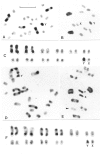Genomic changes of Chagas disease vector, South America
- PMID: 15109410
- PMCID: PMC3322799
- DOI: 10.3201/eid1003.020812
Genomic changes of Chagas disease vector, South America
Abstract
We analyzed the main karyologic changes that have occurred during the dispersion of Triatoma infestans, the main vector of Chagas disease. We identified two allopatric groups, named Andean and non-Andean. The Andean specimens present C-heterochromatic blocks in most of their 22 chromosomes, whereas non-Andean specimens have only 4-7 autosomes with C-banding. These heterochromatin differences are the likely cause of a striking DNA content variation (approximately 30%) between Andean and non-Andean insects. Our study, together with previous historical and genetic data, suggests that T. infestans was originally a sylvatic species, with large quantities of DNA and heterochromatin, inhabiting the Andean region of Bolivia. However, the spread of domestic T. infestans throughout the non-Andean regions only involved insects with an important reduction of heterochromatin and DNA amounts. We propose that heterochromatin and DNA variation mainly reflected adaptive genomic changes that contribute to the ability of T. infestans to survive, reproduce, and disperse in different environments.
Figures




Similar articles
-
Origin and phylogeography of the Chagas disease main vector Triatoma infestans based on nuclear rDNA sequences and genome size.Infect Genet Evol. 2006 Jan;6(1):46-62. doi: 10.1016/j.meegid.2005.01.006. Epub 2005 Apr 20. Infect Genet Evol. 2006. PMID: 16376840
-
Evolutionary and dispersal history of Triatoma infestans, main vector of Chagas disease, by chromosomal markers.Infect Genet Evol. 2014 Oct;27:105-13. doi: 10.1016/j.meegid.2014.07.006. Epub 2014 Jul 11. Infect Genet Evol. 2014. PMID: 25017654
-
A new method for forensic DNA analysis of the blood meal in chagas disease vectors demonstrated using Triatoma infestans from Chuquisaca, Bolivia.PLoS One. 2008;3(10):e3585. doi: 10.1371/journal.pone.0003585. Epub 2008 Oct 30. PLoS One. 2008. PMID: 18974787 Free PMC article.
-
Insecticide resistance in vector Chagas disease: evolution, mechanisms and management.Acta Trop. 2015 Sep;149:70-85. doi: 10.1016/j.actatropica.2015.05.014. Epub 2015 May 21. Acta Trop. 2015. PMID: 26003952 Review.
-
Can wild Triatoma infestans foci in Bolivia jeopardize Chagas disease control efforts?Trends Parasitol. 2005 Jan;21(1):7-10. doi: 10.1016/j.pt.2004.10.007. Trends Parasitol. 2005. PMID: 15639733 Review.
Cited by
-
Seroepidemiological study of chagas disease in the southern Amazon region of ecuador.Trop Med Health. 2013 Mar;41(1):21-5. doi: 10.2149/tmh.2012-31. Epub 2013 Feb 14. Trop Med Health. 2013. PMID: 23532947 Free PMC article.
-
Comparative repeatome analysis on Triatoma infestans Andean and Non-Andean lineages, main vector of Chagas disease.PLoS One. 2017 Jul 19;12(7):e0181635. doi: 10.1371/journal.pone.0181635. eCollection 2017. PLoS One. 2017. PMID: 28723933 Free PMC article.
-
Potential impact of climate change on the geographical distribution of two wild vectors of Chagas disease in Chile: Mepraia spinolai and Mepraia gajardoi.Parasit Vectors. 2019 Oct 14;12(1):478. doi: 10.1186/s13071-019-3744-9. Parasit Vectors. 2019. PMID: 31610815 Free PMC article.
-
Distribution and evolution of repeated sequences in genomes of Triatominae (Hemiptera-Reduviidae) inferred from genomic in situ hybridization.PLoS One. 2014 Dec 5;9(12):e114298. doi: 10.1371/journal.pone.0114298. eCollection 2014. PLoS One. 2014. PMID: 25478792 Free PMC article.
-
Intrusive versus domiciliated triatomines and the challenge of adapting vector control practices against Chagas disease.Mem Inst Oswaldo Cruz. 2015 May;110(3):324-38. doi: 10.1590/0074-02760140409. Epub 2015 Mar 14. Mem Inst Oswaldo Cruz. 2015. PMID: 25993504 Free PMC article.
References
-
- World Health Organization. Control of Chagas disease. Second report of the WHO Expert Committee. World Health Organization Technical Report Series. Geneva. Organization. 2002;▪▪▪:1–109.
-
- Torrico RA. Hallazgo de Eratyrus mucronatus, infestación natural de “vinchucas” de cerro y Eutriatoma sordida en Cochabamba. Ann Lab Central Cochabamba. 1946;1:19–23.
-
- Dujardin JP, Tibayrenc M, Venegas E, Maldonado L, Desjeux P, Ayala F. Isozyme evidence of lack of speciation between wild an domestic Triatoma infestans (Heteroptera: Reduviidae) in Bolivia. J Med Entomol. 1987;24:40–5. - PubMed
-
- Bermúdez H, Valderrama F, Torrico F. Identification and characterization of sylvatic foci of Triatoma infestans in Central Bolivia. Am J Trop Med Hyg. 1993;49:371.
Publication types
MeSH terms
LinkOut - more resources
Full Text Sources
